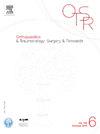多孔定制植入物的位置是否与规划一致,并能在复杂髋臼翻修术 Paprosky III 中对髋关节旋转中心进行解剖重建?
IF 2.3
3区 医学
Q2 ORTHOPEDICS
引用次数: 0
摘要
导言:在翻修全髋关节置换术(THA)中,多孔定制三凸缘髋臼植入体的出现和三维扫描规划为提高植入精度和旋转中心(COR)的解剖修复提供了新的视角。我们使用 CT 扫描作为测量工具对这一问题进行了研究,但研究范围有限(±10 个病例),且未对可能影响定位误差的因素进行调查。因此,我们进行了一项回顾性研究,旨在(1)根据术前规划评估此类种植体的植入准确性,(2)研究为植入种植体而切除的骨量是否会影响植入准确性,(3)评估手术中的位置误差是否会影响功能、并发症和存活率:假设:在植入多孔定制髋臼假体时,可以准确再现术前规划,但准确性会随着切除骨量的增加而降低。 方法:这项单中心回顾性研究纳入了 20 例接受 THA 翻修术并植入多孔定制髋臼假体的患者。平均随访时间为 17.9 个月 ± 9.4 [2-45.1]。使用三维扫描建模进行术前规划。术后进行了CT扫描,以评估植入方向和COR恢复的准确性。记录了人口统计学数据、牛津评分、并发症和存活率:结果:与术前规划相比,倾斜、内翻和旋转的平均偏差分别为 4.3 ° ± 2.5、6.1 ° ± 4.7 和 7 ° ± 4.6。COR恢复的平均偏差为前胸(2.1 ± 1.3)毫米,内侧(2.5 ± 2)毫米,近端(2.2 ± 1.3)毫米。总共有 45% 的种植体(9/20)在定位时完美地恢复了方向(±10°)和 COR(±5 毫米)。计划切除的骨量平均为 8.1 ± 4.9 cm3,当需要切除的骨量超过 2.7 cm3 时,植入的准确性和 COR 恢复显著降低。发现了一次脱位(5%,1/20)。最后一次随访的存活率为100%,随访时的平均牛津评分为31.7 ± 7.9 [16-52],不受位置或COR复原误差的影响:结论:总共有 45% 的种植体按计划恢复了方向和 COR,尤其是当需要切除的骨量小于 2.7 cm3 时。虽然这些病例情况复杂,骨质流失量大,但三维制造技术可以为我们带来更高精度的希望。更好的精确度与低骨切除量之间的联系可能是与制造商共同开发的一个领域,以改善结果:证据等级:III;在横向回顾性研究中使用 CT 进行诊断。本文章由计算机程序翻译,如有差异,请以英文原文为准。
Do the porous custom implants have a position consistent with the planning and allow anatomical reconstruction of hip center of rotation in complex acetabular revisions Paprosky III?
Introduction
In revision total hip arthroplasty (THA), the advent of porous custom-made triflange acetabular implants with 3D scan planning offers a new perspective to improve implantation accuracy and anatomical restoration of the center of rotation (COR). This issue was investigated using CT-scan as the measurement tool, but in limited series (±10 cases) and without investigating the factors that may influence errors in positioning. Therefore we performed a retrospective study aiming to: (1) assess the placement accuracy of such implants with respect to the preoperative planning, (2) examine whether the volume of bone to be resected in order to apply the implant had an impact on this accuracy, (3) assess if errors in position at surgery had any influence on function, complications and survival.
Hypothesis
Preoperative planning could be accurately reproduced when implanting porous custom-made acetabular implants, and that accuracy would decrease in proportion to the volume of bone to be resected
Method
Twenty patients undergoing THA revision with porous custom-made acetabular implants were included in this single-center retrospective study. Mean follow-up was 17.9 months ± 9.4 [2–45.1]. Preoperative planning was performed using 3D scanographic modeling. A post-operative CT scan was performed to assess implantation accuracy in terms of orientation and COR restitution. Demographic data, Oxford scores, complications and survival were recorded.
Results
Mean deviation from the preoperative planning in inclination, anteversion and rotation were 4.3 ° ± 2.5, 6.1 ° ± 4.7, and 7 ° ± 4.6, respectively. Restoration of the COR showed a mean deviation of 2.1 ± 1.3 mm anteroposteriorly, 2.5 ± 2 mm mediolaterally and 2.2 ± 1.3 mm proximodistally. In total, 45% (9/20) of implants were positioned with perfect restoration of orientation (±10 °) and COR (±5 mm). The mean planned bone resection was 8.1 ± 4.9 cm3, with placement accuracy and COR restitution decreasing significantly when the volume of bone to be resected exceeded 2.7 cm3. One dislocation was found (5%, 1/20). Survival at last follow-up was 100%, the mean Oxford score at follow-up was 31.7 ± 7.9 [16–52], without being influenced by errors in position or COR restitution.
Conclusion
In total 45% of the implants restored an orientation and a COR as planned, particularly when the volume of bone to be resected is less than 2.7 cm3. Although these are complex cases with large amounts of bone loss, 3D manufacturing could give us hope of greater precision. The link between better precision and low bone resection volume could be an area to develop with the manufacturer in order to improve results.
Level of evidence
III; diagnostic using CT in transversal retrospective study
求助全文
通过发布文献求助,成功后即可免费获取论文全文。
去求助
来源期刊
CiteScore
5.10
自引率
26.10%
发文量
329
审稿时长
12.5 weeks
期刊介绍:
Orthopaedics & Traumatology: Surgery & Research (OTSR) publishes original scientific work in English related to all domains of orthopaedics. Original articles, Reviews, Technical notes and Concise follow-up of a former OTSR study are published in English in electronic form only and indexed in the main international databases.

 求助内容:
求助内容: 应助结果提醒方式:
应助结果提醒方式:


